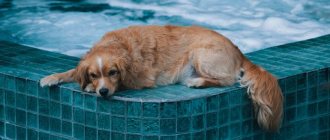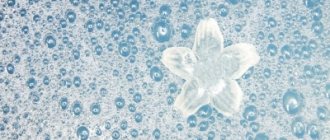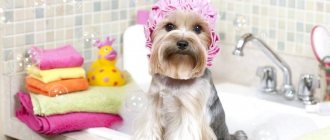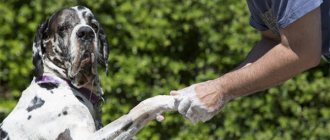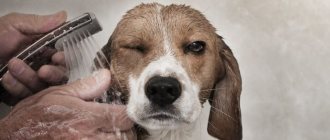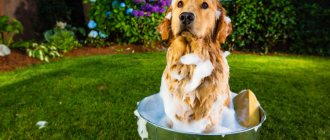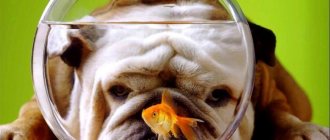Composition and properties of soap
Tar and laundry soap contain components that are aimed at solving specific problems.
Degtyarnoe
Tar soap has a strong and pungent odor. The color is dark brown, but does not stain the skin. The main components of the product are:
- Birch tar. Gives soap a specific aroma. The concentration of the component does not exceed 10%.
- Phenol and alkali. Aimed at breaking down fats and fighting bacteria.
- Sodium salts. Protect the skin surface from moisture loss, preventing overdrying of the skin.
Tar soap as a dog wash
Manufacturers add water, glycerin, fatty acids and oils to the main components. They additionally moisturize the skin. When buying soap with tar, you need to carefully read the composition. The product must not contain Diethylene Glycol. This component has toxic properties. If soap suds are swallowed, the animal may be seriously poisoned.
Many people use tar soap for fleas on dogs. It is believed to have antiparasitic properties. The strong smell repels insects. Benzene from birch tar slows them down, and phenol and alkali burn fleas, but do not kill them due to the protective shell. Soap has no effect on the larvae.
Note! Tar soap for fleas for dogs repels parasites, but only for a few hours. Then they can return to the pet’s body again. While the product is in effect, they must be removed from the animal.
Tar soap improves skin condition. The product eliminates seborrhea, dries out skin rashes and reduces atopic dermatitis. Helps reduce pain in case of flea bites.
Economic
The bar of laundry soap has a light or dark brown color, a natural composition without fragrances or preservatives.
Types of laundry soap with different concentrations of fatty acids
Thanks to simple ingredients, it perfectly cleanses of any impurities. Main components:
- Animal acids. Can be in concentrations of 65%, 70% and 72%. The higher the proportion of the component, the better the foaming properties of the product.
- Alkali. Helps remove stains by breaking down fat.
Additional Information. Sometimes coconut oil and a light variety of rosin are added to soap. The components help moisturize the skin.
Laundry soap is suitable for removing stubborn stains on clothes and doing housework. It perfectly washes away any dirt. You should not shower, wash your face with this product or use it for intimate hygiene, as it dries the skin, causing irritation.
Many people do not know whether it is possible to bathe a dog with laundry soap. It is not recommended to apply the product to your pet. It removes the protective layer from the animal's hair. The skin dries and itches. Dermatitis and hair loss are possible.
Why it is not recommended to wash your dog with conventional means
Our usual cosmetics are designed taking into account the characteristics of human skin. It is not suitable for four-legged pets for the following reasons:
- High level of acidity (pH). It is necessary for high-quality removal of sebum. In dogs, it is secreted in a smaller volume, and their skin is much softer and drier. Because of this, conventional products completely remove the protective fat barrier, increasing the body’s vulnerability to bacteria, and dandruff and inflammation appear on the sensitive epidermis.
- Strong aroma. Animals' sense of smell is sharper. Inhaling odorous substances is not only unpleasant for them, but also dangerous. Frequent inhalation of too strong odors can weaken the sense of smell, which is extremely undesirable for representatives of hunting breeds.
- A large number of harmful substances in the composition. Flavors and colors are usually added to budget brands that are most popular. They cause allergies in dogs.
Thus, the use of conventional products is fraught with deterioration of the skin and coat. Despite this, one-time use of some of them is permissible subject to a number of conditions.
How to wash a dog with tar soap
Is it possible to wash a dog with human shampoo?
If you find fleas on your dog, you can try using a natural remedy to get rid of the parasites. It is better to comb out fleas after bathing your pet. To wash a puppy you need a basin; for a large animal, a bath is suitable. You will need a fine-tooth comb, a flea jar, a bath towel and dog soap.
To wash your dog, you need to follow these steps:
- Place your pet in the bath.
- Turn on warm water and rinse the dog with it.
- Beat the foam separately and lather the pet's entire body, working on the stomach, armpits, and paw pads. It is important to ensure that soap suds do not get into your ears, mouth or eyes. Soap can begin to burn mucous membranes.
- Rinse the dog with clean water and soap again, leaving the foam for 5 minutes.
- Rinse off the foam and remove the fleas with a comb, placing them in a jar with a high neck.
- Rinse your pet with water and dry thoroughly with a soft towel.
The procedure must be carried out every 3-4 days to get rid of fleas.
The procedure for washing a pet using a product with tar
Using pet paw cleaner
Frequent washing of dogs is contraindicated, but this does not apply to cleaning the surface of the paws. Pets are walked several times a day. In bad weather, the paws become very dirty; the animal's pads can cause a dangerous infection. Therefore, the dog needs to wash its paws after every time it goes outside.
How often can you wash your dog and puppy with shampoo?
For minor contamination, the paws can be rinsed with clean water or wiped with a damp cloth. If the dog is very dirty, then you need to use special paw washing products.
Soap with tar is suitable for this purpose. It washes dirt off the paw pads and fur well. If there are small wounds and scratches, it will help to disinfect them. The main thing is to rinse off the soap suds well afterwards. When licking an animal's paws, do not allow any remaining product to get into the mouth.
Important! You can use tar soap only for heavily soiled areas. Economic use is not recommended. It causes cracks in the paw pads.
Contraindications
There are practically none - natural tar soap is safe even when licking wool after washing. But they, like any drug, should not be abused .
You can use this soap for dogs no more than twice a week; it is advisable not to get carried away with prevention and alternate with something else. Otherwise, the fur will lose its shine and become drier and unruly. In the future, you can even achieve shaggy and shabby hair.
This will also have a negative impact on the skin : there will be a feeling of tightness that will bother the animal.
When you decide to try tar soap on your pet, watch his reaction. If the dog expresses strong dissatisfaction with the smell, there is no need to force it; today there are many other means . If everything is fine, then using environmentally friendly soap will bring exceptional benefits to your pet.
What to do if your dog is afraid of water
Is it possible to wash a dog after vaccination: after how long is it allowed?
Many dogs have a fear of water and the washing process. In puppies, fear may be associated with deep baths. Therefore, the best way to reduce anxiety is to bathe babies in a bowl of water. In adult animals, fear can be caused by a stream of water. Therefore, you need to rinse them using a basin with water already filled into it.
It is difficult to get adult pets with a fear of water to get into the bathtub and stand there quietly while they are soaped. You can prevent your pet from escaping from the bathroom by putting a leash on your pet to the bathroom faucet. During the washing process, you should speak kindly to the dog to reduce its stress. After the procedure, the pet is praised and given its favorite treat.
How often?
Typically, the frequency of washing your pet directly depends on its age, body weight, coat length and time of year. There is an opinion that you need to wash your dog as needed - both when it gets dirty and in the basin. But is it possible, and most importantly, how often should you wash your dog?
After a walk, you can wash your paws every time you return home. After all, no dog wants to listen to complaints from the owner for a soiled carpet or smeared parquet floor. And you don’t need any extra cleaning yourself. But if the time of year and the weather are not rainy, it is quite enough to simply wipe your pet’s paws with a damp cloth and avoid another trip to the bathroom.
How often can you bathe or rinse your handsome dog? In principle, if you rinse your dog with clean water once every 1-2 weeks, there will be no particular harm. But there's no point either. We still do not recommend that you “clean” your dog’s fur too zealously - you can disrupt the functioning of the sebaceous glands and get a problem in the form of a disgusting smell of fish, dog or mushrooms.
We solve problems quickly: why does my dog smell like dog, fish or rotten meat?
But if you come home like this, then immediately run to the bathroom and grab more shampoo!
How many times?
How often, or rather how many times a month, can and should you wash your pet with shampoo? It’s also not worth exhausting your pet with bath procedures every month, since the natural protective fat layer on the dog’s fur will do an excellent job of cleansing it of excess dirt without our help.
The only exceptions in this situation can be exhibitions or any indications from dog handlers or veterinarians.
It is recommended to bathe your dog annually no more than once every 3 months, or even less often. This procedure should not be mandatory and unconditional. Just keep an eye on the condition of your pet’s coat, and if you think it’s necessary, you can give your dog a bath day.
Is it possible...
in winter
Many people ask how often they should wash their pet in winter. In general, strictly speaking, it is not advisable to bathe your pet in winter. Since low air temperatures cannot have a positive effect on your dog, it is better to postpone bathing until the warm season.
Some breeds with thick coats and additional undercoat can take up to two days to dry. And in winter it is incredibly easy for even the largest and fluffiest dog to catch a cold.
After vaccination
After vaccination, your animal’s immunity is weakened, because it is experiencing a fight with new antibodies in its body. Therefore, all veterinarians recommend bathing dogs before vaccination day. A weakened immune system may simply not be able to withstand the next wash and a simple vaccination will become the source of many complications. For such animals, regular combing is recommended, which also perfectly keeps the coat in good condition.
Pregnant
Pregnancy is not considered a disease. However, it is extremely important to protect your dog during this period from negative effects on its body. And if you decide to bathe a pregnant dog, then you will need to adhere to extremely careful manipulations in order to protect it from hypothermia, injury and infections. Since the loop may remain open for some time after mating, it is important to monitor the purity of the water (do not swim in natural bodies of water) and its temperature.
During heat
It is not advisable to bathe your pet during heat, as this can lead to colds of the genitourinary system. If you wash or bathe your dog, it is better to use special disinfectants. However, simply wiping the delicate areas will be quite enough - you will protect yourself from colds and reduce the smell a little.
Head and ears
It is strictly not recommended to water the head, or more precisely the muzzle, with water. If you decide not to avoid this part of the body when bathing, then it is best to simply wipe the face with a damp palm or sponge without soaping it. No matter how hypoallergenic your shampoo is, getting it into your eyes is highly undesirable. Also be careful not to let water get into your ears while swimming. This is fraught with otitis media and other inflammatory diseases.
Before vaccination
If the dog is already old enough, before vaccination it is recommended not only bathing, but also flea treatment, deworming and ear cleaning for ticks. Since the immune system is weakened after vaccination, you are unlikely to be able to give your pet a bath in the near future, so it is more rational to bathe him before going to the veterinary clinic. But still, if this is not necessary, you should not wash the animal again.
Before birth
Before giving birth, bathing a pregnant dog is not particularly recommended. Your animal’s body is too busy with another very important process and is just in the stage of preparation and restructuring, and unnecessary interference in its physiology will only cause additional stress. You don't want to give birth right in the bathroom, do you?
Cleaning the premises after washing the dog
After water procedures and combing out fleas, the room should be treated. Parasites from the animal jump onto walls, rugs and get into cracks in the floor.
A type of flea that lives on animals
After the procedure is completed, they can again move to the pet. Therefore, the floor and walls need to be washed and disinfected. The rugs are washed with detergent.
After bathing, the dog needs new bedding. Fleas and their eggs remain on the old one, so the pet becomes infected with them again. If you can’t buy a new dog bed, you can wash it several times. All steps should be repeated after each washing and combing of the animal.
Precautions when using tar products
Thanks to its simple composition, tar soap is not as toxic as many modern household chemicals. Preservatives, dyes, components for abundant foaming negatively affect the well-being of the pet.
Some manufacturers of household chemicals add Diethylene Glycol, which is toxic to animals, to soap with tar. When buying a product, you need to carefully read the composition. This component should not be present in the product. The substance causes food poisoning.
When washing your dog with soap and tar, you need to be careful not to get it in your mouth, eyes or ears. The strong odor may cause dizziness in some people. Therefore, during water procedures, the door to the bathroom should be kept open.
Consequences of using soap to wash dogs
Tar soap is not a very suitable product for bathing dogs, especially for frequent washing. It is used to solve a specific problem - flea control. The strong, pungent smell of soap can repel parasites, but the aroma of tar is also unpleasant for animals.
Specialized shampoos for dogs
The alkali in the product causes burning of the mucous membranes and their irritation, so the pet must be washed carefully so that foam does not get into the eyes, nose, ears and mouth. Soap destroys the protective fat film, which causes dry skin and coat. With frequent use, dermatitis and dandruff appear.
Note! For dogs, it is better to use special shampoos from pet stores that are designed for animals.
Can tar soap be used to fight fleas?
Pet stores and hypermarkets are overflowing with various modern drugs for parasites. But they are not always harmless for pets and people; their use can lead to unexpected allergic reactions, which are sometimes not even listed among the contraindications for use in the leaflets for the drugs. Not all products can be used on puppies and kittens, but the soap can be used as early as the fifth week of life for small kittens and dogs, and even for pregnant and lactating animals.
Tar soap is not as effective in killing fleas as modern drugs, but unlike them, it does not have any side effects that ruin life and require additional funds for treatment.
Common Misconceptions About Using Soap for Dogs
When asked whether it is possible to wash a dog with regular soap, many give a positive answer. It is believed that an animal can be washed with any means, but tar and baby soap, when used frequently, dry out the pet’s delicate skin and fur, causing hair loss and dandruff. A similar effect appears after using human shampoos and shower gels.
For animals, you should use special dog shampoos. The manufacturer of pet products "Clandestine" produces tar soap specifically for dogs with moisturizing additives and a lower alkali content.
Another common misconception is that animals can be washed with dust soap; it kills fleas and ticks well. This product should not be used on dogs. It contains pesticides that can poison your pet.
Features of use
Tar soap is used in veterinary medicine not only against fleas in dogs and cats. Using a natural remedy, they remove ticks and fight seborrhea, dermatitis, and skin infections. It is recommended to use for the prevention of parasites in absolutely healthy pets.
But you shouldn’t get carried away with tar soap. From frequent use, the coat becomes dull and unruly. It is advisable to alternate natural soap with other caring and medicinal products.
Advantages and disadvantages of tar for animals
There are different attitudes towards washing animals with soap. If you doubt whether it is possible to wash your dog with tar soap, you should figure out what its advantages and disadvantages are.
The following are the advantages of soap with tar:
- Simple composition. It does not contain components that cause vomiting, skin burns or allergies.
- Good cleaning ability. The product removes heavy dirt from the animal's fur.
- Eliminating fleas. The smell of tar scares the parasites and they leave the surface of the pet. Benzene makes insects slower, making them easier to remove from fur with a comb.
- Relieving inflammation from pediculosis. The dog stops experiencing skin itching and scratching himself.
- Wound healing. Soap with tar has a disinfectant effect. Scratches and wounds heal faster. It also dries out cracked skin from eczema and dermatitis.
Manifestation of dermatitis in a dog
The disadvantages of the product include:
- Appearance of irritation. Soap suds have a negative effect on mucous membranes. They may turn red and begin to itch.
- Frequency of washing. You cannot wash your dog with tar soap every day. It dries out the skin and coat. When treating an animal for fleas, the interval between washing should be 3 days.
- Pungent aroma. The product has a strong smell of birch tar. It can be unpleasant to people and animals. The aroma can cause dizziness. It stays on the dog's fur for 2 hours.
- Ineffective control of flea eggs. Soap is not capable of destroying insect larvae. They need to be removed using a comb and special anti-parasite products.
You need to wash your dog with tar carefully and not often, then it will be effective in eliminating various problems in the animal.
Important! After using soap with tar, you need to carefully monitor how your pet reacts to the use of the product.
You cannot wash your dog often with tar soap, and the product does not completely destroy fleas. The smell of tar eliminates them for only a few hours. It is better to wash your dog with animal shampoo, which gently removes dirt.
What is the best way to wash your dog?
In order to properly care for your dog’s coat and skin, it is recommended that you contact a specially trained person, such as a veterinarian. Is it possible to do without the help of a specialist? Yes, sure. In this case, we recommend that you read reviews about this or that dog care product. But, in any case, it is necessary to take into account that you will have to change more than one bottle of shampoo, and more than one bar of soap. Why is this happening? It's simple. Just like people, dogs can develop allergies or individual intolerance to a particular product.
We advise you to read: Why does a dog smell?
In a modern pet store there are various products for caring for a dog’s fur and skin, the pricing policy is also different (from 100 rubles to 2000-3000). Unfortunately, a high price does not always mean that you have a quality product.
Some unscrupulous manufacturers add dyes, preservatives, fragrances and other various additives to care products that can harm your beloved pet. Therefore, before making any purchase, we strongly advise you to read reviews and study the composition of the product.
We have already found out that washing a dog completely is not necessary as often as a person. In this connection, many believe that it is not necessary to purchase special soap. Let's figure out together whether a dog needs a separate hygiene product or can you use what everyone has at home. We are often asked questions: Is it possible to wash a dog with baby soap? Can I use laundry soap? Which liquid soap is better to take? What to do if your dog is allergic to shampoos, what soap should you buy? What should you do if your dog has fleas and is allergic to a product from a veterinary pharmacy? Are there natural soaps for dogs?
Now we will try to answer these questions one by one.
Is it possible to wash a dog with tar soap if parasites are detected?
Since ancient times, our ancestors have resorted to natural, safe remedies to help remove parasites from animals. Such a remedy is tar soap. Therefore, you can use this dog wash both as a special remedy for getting rid of fleas and for daily washing of paws.
Tar soap can also be used to wash dogs with dermatitis. This soap will help heal small wounds, relieve redness, and relieve itching.
Is it possible to use laundry soap to wash a dog?
Laundry soap is a wonderful thing. This is an absolutely natural product that does not contain flavors, dyes, or fragrances. It can be used to wash hard-to-remove stains; it washes away almost any dirt. This is its positive side, but there is also a negative side. Under no circumstances should you use laundry soap to wash your dogs. It has a detrimental effect on the condition of the dog’s coat and skin, since this soap contains a large percentage of alkali. It is not recommended to use laundry soap even for washing paws. Only a specially created dog wash can provide proper care for the condition of your pet's coat and skin.
We advise you to read: Should you brush your dog’s teeth?
Can I wash my dog with regular baby soap?
The answer to this question is ambiguous. Baby soap has a lower pH than regular soap. Therefore, baby soap can be used in extreme cases. For example, when you have run out of soap for dogs at home, and you urgently need to bathe your dog, because while on a walk he decided to have fun in a dirty puddle. Also, baby soap can be used when washing paws when you come to visit relatives with your beloved dog, and you don’t have a spare bar of soap for dogs with you. We conclude: we rarely use baby soap.

